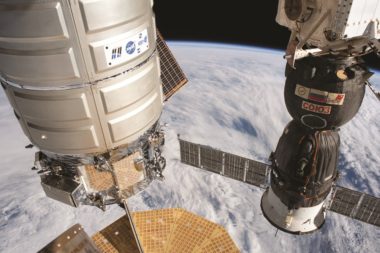This op-ed originally appeared in the August 19, 2019 issue of SpaceNews magazine.
During Apollo’s heyday, large organizations like NASA ran on programmatic, linear planning models. MBAs were taught to develop business plans and boards held management accountable to the predefined objectives and milestones within them. “Deviation from plan” was equated with failure.
Five decades after Apollo, NASA — burdened with an old-school management culture — originally offered a linear, programmatic solution to its most recent White House mandate to return Americans sustainably to the moon. That was a mistake, but it need not be a fatal one.
The current goal of sustainably returning to the moon and then moving on to Mars was originally crafted by the 2016-2017 NASA transition team on which I served. It was reinforced and given an aggressive 2024 deadline by U.S. Vice President Mike Pence in an inspirational speech in Huntsville, Alabama, in March. NASA Administrator Jim Bridenstine, speaking in June at the International Space Development Conference, praised the clear deadline as an effective tool for reducing the political risk. Political changes have wrecked several previous NASA exploration programs, including Constellation, Journey to Mars and the Asteroid Redirect Mission. These missions were developed by NASA’s human exploration team, a talented group burdened with 1960s-style management. Not surprisingly, the first solution to the new goal that came out of NASA’s traditional thought processes was to throw more money at the old plan, execute it with the usual people and hope for different results. Also not surprisingly, that effort generated more slippages and stirred up new political risk. Thankfully, that phase has clearly been ended.

In today’s business world, a new dynamism has vanquished linear thinking everywhere that organizations are driven to achieve audacious results via innovation in a changing environment. Modern, high-performing organizations eschew old-school business plans as they gather flexible resources and work to establish a diverse set of capabilities that will allow them to innovate and iteratively pursue current and unknown future organizational goals. When necessary, they are ready to pivot, making a swift and substantial change away from their original path. Pivoting requires accepting failure frequently and openly, while allowing for quick, recrimination-free moves back to the path of success, reducing the impact of these failures. “Fail early, fail often,” as they say in Silicon Valley.
SUCCEEDING WITH WHAT WE HAVE
How might modern management be applied to NASA’s current situation? It would be absurd to imagine that anyone at NASA has been given a blank slate and asked to craft an innovative space program from whole cloth; this is not a fresh start. While the Trump administrations’ goal of returning to the moon in a permanent and economically sustainable manner has received bipartisan support and kudos from both traditional and commercial space interests, NASA’s available kit of spacecraft was crafted for other, less realistic objectives. Specifically, we have systems left over from the nebulous Journey to Mars and the uninspiring Asteroid Redirect Mission. Many people at NASA and even members of the last administration’s space team privately admit they never actually expected either of those programs to succeed, but today’s incomplete space systems nevertheless were designed for them.
Today’s reality is that NASA has a new launch vehicle, the Space Launch System, approaching testing. SLS currently suffers from the lack of a reasonably powered upper stage engine. We also have Orion, a very capable deep space crew capsule that while twice the capacity and weight of an Apollo Command Module is saddled with a service module offering about one-fourth the thrust. The combined SLS Interim Cryogenic Propulsion Stage and Service Module are frustratingly incapable of delivering an Orion crew to low lunar orbit and returning them to Earth, making a direct moon landing impossible. Further distressing is the fact that SLS and Orion seem to be perennially “nearly ready to fly” and over budget, prompting a scathing review by the U.S. Government Accountability Office that surely spurred recent moves of key personnel.
On the commercial side, NASA under the Obama administration, wisely built upon the successful Commercial Orbital Transportation Services program with Commercial Crew. SpaceX and Boeing have designed and are testing capsules that will ride on flight-proven Atlas 5 and Falcon 9 rockets. However, both capsules have encountered delays and frustrating test failures. They will both miss the oft-bragged upon goal of flying Americans astronauts on American rockets from American soil this year. Further, neither commercial capsule is suitable for a lunar voyage. So how in heaven’s name do we get to the moon in a timely manner with this fleet?

BRINGING NEW MINDS TO BEAR
Under the leadership of Bill Gerstenmaier, a brilliant engineer for whom I will always have the deepest personal respect, NASA’s Human Exploration and Operations Mission Directorate put forward an ingenious solution based on previous work, the Lunar Orbital Platform-Gateway. While I supported that solution, I personally argued against the name Gateway because I felt it was a limiting description of a very versatile vehicle. Worse, Gateway allowed this resource to be incorrectly framed as a choke point by the inevitable detractors. I felt “Deep Space Ship” would better highlight the mobility and flexibility of this platform which can move to a variety of cislunar orbits, including leaving the moon to swing through accessible Earth orbits (geostationary transfer orbit, for instance) and back to the moon. The propulsion that makes this possible is the Advanced Electric Propulsion System. AEPS is solar-powered Hall thruster originally developed by NASA Glenn Research Center and the Jet Propulsion Laboratory for the Asteroid Redirect Mission that NASA pursued under Obama. To the further credit of Gerst and his team, most of the ARM spending was directed at this generally useful technology.
NASA’s specific plan for utilizing the Gateway in support of a 2024 lunar landing has been to position the Gateway in a near-rectilinear halo orbit (NRHO), which stretches between circling the moon and L1 or L2 points in space 50,000 miles from the moon. This position allows the Gateway to achieve a location and vector that permit a current SLS-launched Orion to dock with it as well as swinging near the lunar pole to deposit crew in a lander. Moving to other interesting lunar orbits from the NRHOs requires very little energy. All the moon’s a playground with the Gateway and a versatile lander. This is a realistic and daring solution to the demands of engineering, budgets and politics.
The Gateway has, however, garnered significant criticism from some space advocates who would scrap our entire investment in existing systems and develop new, primarily commercial architectures to go directly to the surface of the moon. Notable among these critics are Apollo 11 astronaut Buzz Aldrin and The Mars Society founder and president Robert Zubrin, two people I have also had the pleasure to work with and greatly admire. Zubrin has focused on in-situ resource utilization on the lunar surface as a means for reducing the surface payloads necessary to support habitation and the ascent stage of the lander. Aldrin argues the Gateway should be positioned in Earth orbit for a number of reasons and that a refuelable tug be used to deploy assets to the moon for the landing. These are good ideas that also offer dynamic thinking utilizing existing, commercial rockets.
The Gateway doesn’t care where it is sent, and United Launch Alliance has proposed converting upper stages into tugs using their innovative ACES design. Jeff Bezos’ Blue Origin has similar ideas and has had a lunar lander design under development for several years; I first saw the Blue Moon proposal in December 2016. While they are simpler, these commercial-based proposals do lack components that the traditional teams have nearly completed, notably a deep space capsule. They are also based on programmatic thinking, full of linear dependencies that recent history suggests will also experience failures and slippages.
Consequently, the correct route forward for NASA is a multilinear one, free of dependence on any one component and focused on building useful infrastructure. A successful, 21st century space agency must gather resources and establish capabilities that can be reconfigured to address changing technical and political climates for years to come. Building such a dynamic kit need not be more expensive and will offer multiple paths to the lunar surface in a competitive process that drives vendors to move quickly at lower costs, rather than embracing caution and seeking higher budgets.
GATEWAY’S VERSATILITY
The Gateway is useful for either of these paths. It is, in fact, a backup transportation system in itself. With a robust habitation module, the Gateway could take a commercially delivered crew from a geostationary transfer orbit to the moon and back. The round trip would take a couple months, a shorter duration than many stays on the International Space Station, albeit in a higher radiation environment. Answering questions about biological exposure to deep space radiation levels and testing shielding materials is part of the Gateway’s mission.

That knowledge is critical to determining how we will send humans to Mars and beyond and knowing if our children might live in the O’Neill style orbital habitats that the National Space Society has been advocating for years. The Gateway is a fundamental piece of space infrastructure for our expansion into the cislunar environment. Maxar Technologies, the winner of the bidding for the first module, the Power and Propulsion Element (PPE), came in 20% lower than the competition in a testament to NASA’s performance-based proposal. It also means the module is much more likely to be delivered in a timely manner and that the vendor will be able to incorporate learning and new technologies. The traditional, specification-driven approach crushed learning and innovation, delivered systems that were behind the technology curve and taught vendors little.
The swift award to Northrup Grumman for the habitation module was equally bold. The decision to base the module on the proven Cygnus cargo capsule was brilliant. Cygnus has been through the NASA scrutiny required to dock with ISS and has flown on three different rockets (Atlas 5 and the Antares 100 and 200 series). The award was done swiftly and while there are legitimate concerns about the sole-source selection, it reflects a badly needed sense of urgency and decision making at the agency. If that sort of active thinking had been available at NASA Headquarters in 2017, we’d be launching Gateway components on commercial rockets early next year. Another recent spate of awards includes one to SpaceX for on-orbit refueling, an equally brilliant, capabilities-focused choice.
The president has also made it clear that delivering humans to Mars remains a national goal. Disruptive thinkers like Zubrin, Aldrin and Elon Musk share this goal with competing ideas on how to achieve it. The Gateway offers a real first step to Mars, not just a proving ground. A Gateway-derived system could be placed in Martian orbit, with components delivered by existing commercial rockets, equipped with a refuelable upper stage engine and aerobraking to enter orbit. Once assembled, a two-person crew could travel in an Orion equipped with an improved service module and refuelable upper stage to occupy such a Mars-based station and explore the Martian moons using solar electric propulsion.
Such missions may very well depart form Aldrin’s Earth Orbit Gateway, because as he correctly notes, the moon is rarely where you want it to be for a timely Martian rendezvous. Very significant research can be conducted at Phobos, as that moon is visibly coated in red material blasted from the Martian surface by meteor strikes. This Martian material could be collected by astronauts and then analyzed immediately in the Martian Gateway, directing further optimized collection for return to labs on Earth. The questions of Martian life could very well be answered at this point, and the value of real Martian regolith for insitu resource utilization operations can be directly validated.
All this could be done at a Mars Gateway for a reasonable price and within the next decade. No budget breaking Mars Ascent Vehicle or unproven in-situ resource utilization capabilities would be required. This is the sort of dynamic, multi-option mission made possible through gathering resources and establishing capabilities rather than defining programs.
LUNAR COTS’ DYNAMISM
Economic development of the moon requires a sustainable presence. Accordingly, sustained presences has been a major component of the space policy directives produced by National Space Council. Achieving that singularly important requirement will require creative and flexible infrastructure on the ground. The Space Portal team at NASA Ames Research Center have developed some of the most practical ideas for lunar surface exploration and development. This innovative group originated the highly successful Commercial Orbital Transportation Services (COTS) program that has kept the International Space Station operational after the retirement of the space shuttle. COTS did far more than that by funding the development of SpaceX’s Falcon 9 rocket Dragon capsule as well as adding the Antares rocket and Cygnus capsule to the growing stable of U.S. spacecraft.

The Space Portal team’s proposed Lunar Commercial Operations & Transfer Services — aka LunarCOTS, or LCOTS — promises to do much of the same for the moon. LunarCOTS is a three-phased approach aimed at providing a full range of assets at bargain prices via competitive commercial proposals. LCOTS Phase One includes the installation of surface infrastructure in the form of robotic landers equipped with deployable solar panel towers and power storage systems. These systems, launchable on existing commercial rockets, will allow for the speedy placement of “stakes in the ground” at important sites near the lunar poles. Just as importantly, an expanding array of these towers will act as navigation aids and communications relays across the lunar terrain for robotic and human exploration. LCOTS Phase One towers could be deployed for significantly less than production budget of the latest installment of the Star Wars movie franchise. Exploration and extraction rovers will utilize these towers for recharging, providing up to 1,600 watts during the day and 70 watts at night. The systems will support the important thermal control needs for these rovers during the lunar night. Phase Two will involve demonstrating the production of significant amounts of propellant from lunar water ice.
The third and final LCOTS phase is the critical handoff to commercial operations, where NASA will contract with multiple vendors for expansion and maintenance of these services, similar to how COTS demo missions laid the foundation for the Cargo Resupply Services contracts under which SpaceX and Northrop Grumman resupply the ISS.
LCOTS vendors can make this same infrastructure available to independent, commercial operators for a fee, in much the same way Falcon 9 has become a workhorse launcher for the broader space industry and Cygnus has morphed into a satellite-servicing vehicle for commercial customers. Eventually, larger versions of LCOTS power, navigation and communications towers will support NASA and, ultimately, privately crewed lunar vehicles. All the envisioned LCOTS capabilities fit into the current Gateway-based plan as well as the alternative direct-to-the-surface scenarios. It also offers solid applications to future Mars’ surface operations as well.
The good news is that by embracing a capabilities-based approach, NASA does not have to choose any one path or start over when politically driven objectives shift. Two years ago, in these same pages, Buzz Aldrin and I endorsed the nomination of Jim Bridenstine for NASA administrator. Bridenstine’s diverse educational background, including three bachelor’s degrees and an MBA along with his experience as a military pilot, museum director and U.S. congressman will serve him well in transforming NASA’s culture from linearity to dynamism. He’s also got youth on his side. At 44, he’s the first NASA administrator born after the Apollo program. Whenever the next administrator comes along, they will benefit from the useful set of tools Bridenstine put in place and NASA will move smoothly toward its new missions, without the fits and starts inherent in transitions under the old programmatic approach.
Greg Autry is director of the Commercial Spaceflight Initiative at the University of Southern California. He served as a member of the Trump administration’s NASA transition team and as the White House liaison to NASA. He is vice president of space development at the National Space Society.
#Space | https://sciencespies.com/space/op-ed-nasa-must-shift-its-focus-to-infrastructure-and-capabilities-that-support-dynamic-missions/
No comments:
Post a Comment